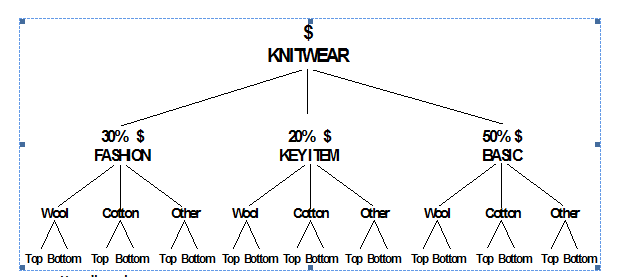ShopTorque
Thoughts, ideas, tips and musings as I work alongside small business owners helping them love their businesses back to life!
Creating a Family Tree
- Font size: Larger Smaller
- Hits: 4900
- Subscribe to this entry
- Bookmark
A Family Tree is a useful system used to capture important information for your business.
A Family Tree is a more detailed extension of the product classifications used in the range assortment plan.
The most useful aspect of this facility is to capture accurate information which will provide valuable historical data as well as a basis for planning your business.
Example of a Family Tree:
How it works
Each item purchased would be given a code that registers with the appropriate description. Therefore at the end of a period in the above example you would be able to determine how many Knitwear Key items in wool you have sold.
QUANTITY ALLOCATIONS
A lot of consideration has already gone into the selection of appropriate product for your business. Setting the correct unit quantities to each item is now the key to the success of that item. There are many methods and formulae that you can use to establish a quantity to be purchased however, before you start calculating this, you must consider the following:
- size of the store (floor and reserve space)
- store turnover
- unit capacity of fixtures
- weeks stock on hand (SOH) that you want to have available
- type of product - fashion, basic, etc
- life expectancy of the item
- historical information
- is it advertised or for a promotion
- pre packed quantity restrictions
After reviewing the above points, you can now have a better idea on how to approach setting your quantities. Example (refer Figure 2.)
After setting the total quantity per item, it may be necessary to break it down further, e.g. size and colour.
Figure 2: Example of Unit Break Up
|
SIZE |
COLOUR |
SIZE |
TOTAL |
UNIT COST |
UNIT RETAIL |
|
KR240 L/S Jacket |
Black (50%) |
S (25%) M (50%) L (25%) |
250
500 250 1000 |
$15.00 |
$35.00 |
|
White (20%) |
S M L |
100 200 100 400 |
$15.00 |
$35.00 |
|
|
Natural (15%) |
S M L |
75 150 75 300 |
$15.00 |
$35.00 |
|
|
Navy (15%) |
S M L |
75 150 75 300 |
$15.00 |
$35.00 |
|
|
KR 240 L/S Jacket |
TOTAL |
S M L |
500 100 500 2000 |
TOTAL COST $30,000 |
TOTAL RETAIL $70,000 |
Much better than guessing or using the "Oooh Aaaah I like it" method of buying. Give it a try and see how you go!
